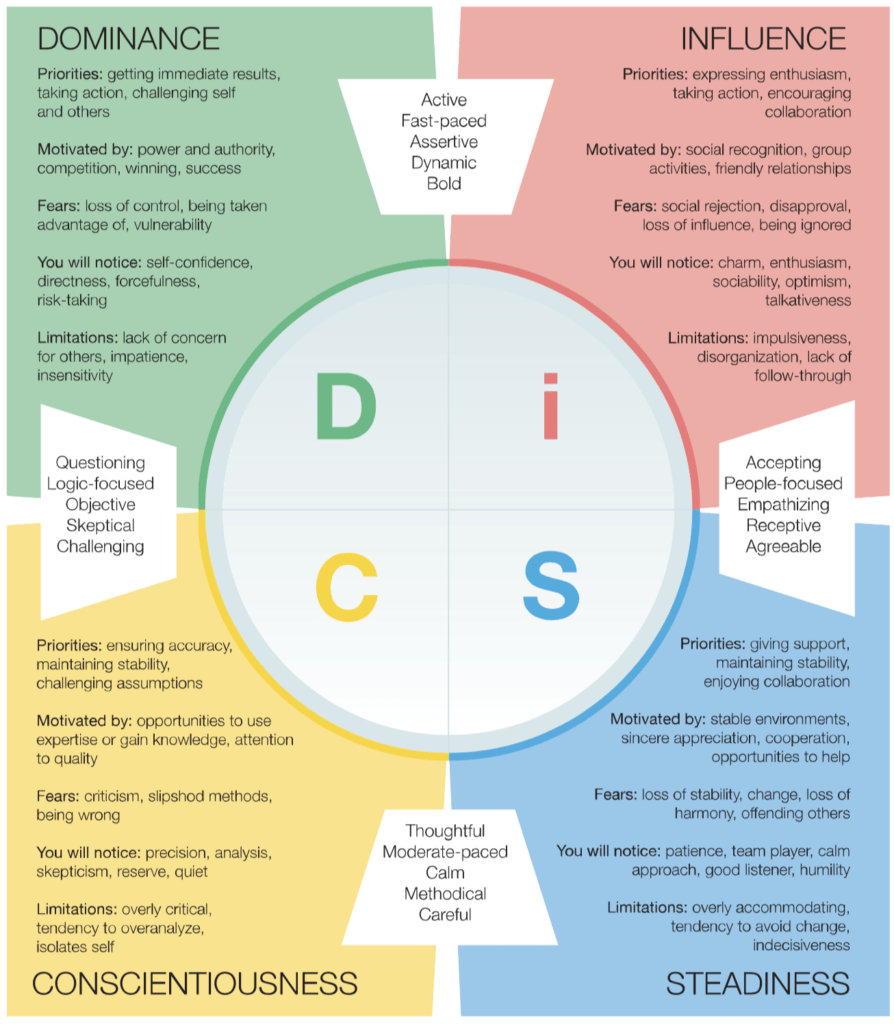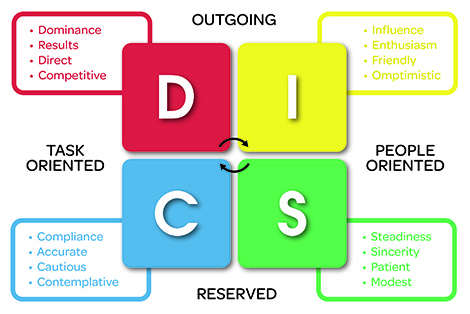In the dynamic landscape of personal and professional development, understanding human behavior is a crucial skill. One powerful tool that has gained prominence over the years is the DISC Personality Test. Developed by psychologist William Moulton Marston in the 1920s, the DISC model categorizes individuals into four primary personality traits: Dominance (D), Influence (I), Steadiness (S), and Conscientiousness (C). This article delves deeper into the DISC test, exploring its applications across various sectors, real-world examples from companies like Target and Johnson & Johnson, and a balanced examination of its pros and cons.
The Four Personality Traits
The DISC model provides insights into dominant personality traits, offering a nuanced understanding of individuals:
- Dominance (D): Assertive, decisive, and goal-oriented individuals who thrive on challenges.
- Influence (I): Sociable, outgoing, and persuasive individuals who excel in building relationships and inspiring others.
- Steadiness (S): Calm, patient, and dependable individuals who value harmony and stability.
- Conscientiousness (C): Analytical, detail-oriented, and systematic individuals who prioritize accuracy and order.

Interpretation of DISC Assessment:
The interpretation of the DISC Personality Test involves understanding the results and the implications of an individual’s placement within the four primary personality traits: Dominance (D), Influence (I), Steadiness (S), and Conscientiousness (C). Here’s a detailed explanation of how to interpret the DISC test:
1. Understanding the DISC Profile:
- Dominance (D): High D scores indicate individuals who are assertive, results-oriented, and enjoy challenges. They often prefer to take charge, make decisions quickly, and focus on achieving goals.
- Influence (I): High I scores signify individuals who are sociable, outgoing, and persuasive. They thrive in social environments, enjoy teamwork, and are effective communicators.
- Steadiness (S): High S scores suggest individuals who are calm, patient, and value stability. They excel in supportive roles, fostering harmony and maintaining a steady pace.
- Conscientiousness (C): High C scores indicate individuals who are analytical, detail-oriented, and systematic. They prioritize accuracy, are thorough in their work, and focus on maintaining high standards.
2. Identifying Dominant Traits:
- Individuals may have one dominant trait, but most people exhibit a combination of traits. For example, someone might have a primary Influence trait but also show secondary characteristics from other categories.
3. Interpreting Combinations:
- The DISC model recognizes that individuals can have a blend of personality traits. For instance, someone with high D and high I scores might be assertive and sociable, combining traits of a leader and influencer.
4. Strengths and Challenges:
- Each trait comes with its strengths and potential challenges. For instance, while high D scores indicate strong leadership potential, the individual may need to be mindful of being perceived as too authoritative.
5. Communication Styles:
- Understanding an individual’s DISC profile helps in tailoring communication styles. For example, communicating with a high D might require brevity and a focus on results, while communicating with a high S might involve a more patient and supportive approach.
6. Work Preferences:
- The DISC test can provide insights into an individual’s preferred work environment and tasks. Someone with a high C score might excel in roles that demand attention to detail and systematic approaches.
7. Team Dynamics:
- Team composition can be enhanced by recognizing the diversity of DISC profiles. Combining individuals with different traits can create a well-rounded team capable of addressing various tasks and challenges.
8. Personal Development:
- The DISC results offer a roadmap for personal development. Individuals can leverage their strengths and work on mitigating potential challenges to become more versatile and effective in various situations.
9. Career Guidance:
- The DISC test can guide career choices by aligning personality traits with specific roles. For example, individuals with high D scores might excel in leadership positions, while those with high C scores may thrive in roles that demand precision.
10. Conflict Resolution:
- Recognizing the different communication styles and preferences of team members based on their DISC profiles can contribute to more effective conflict resolution. Awareness of potential areas of conflict allows for proactive solutions.
Conclusion:
Interpreting the DISC Personality Test involves a holistic understanding of individual traits, recognizing their strengths and challenges, and leveraging this knowledge for personal and professional development. It’s a powerful tool not only for self-awareness but also for enhancing communication, building effective teams, and fostering a positive and productive work environment.
Use Cases in Human Resources
1. Recruitment and Hiring:
- Example: Company X, a tech firm, uses the DISC test to assess candidates for leadership positions, resulting in more successful hires aligned with both technical skills and leadership qualities.
- Pros: Streamlines hiring, enhances cultural fit, and improves onboarding success.
- Cons: Potential oversimplification and lack of consideration for situational behavior.
2. Team Dynamics and Collaboration:
- Example: Company Y, a marketing agency, conducts DISC workshops to foster better collaboration among creative and analytical teams, leading to increased cohesion and efficiency.
- Pros: Boosts team morale, identifies potential conflicts early.
- Cons: May create stereotypical perceptions, effectiveness relies on team commitment.
Use Cases Beyond HR
1. Personal Development and Coaching:
- Example: Individual Z, an entrepreneur, worked with a coach using the DISC model to tailor leadership and communication approaches, leading to improved business outcomes.
- Pros: Enhances self-awareness, provides a structured framework for coaching.
- Cons: Individuals may resist or misinterpret results, may not account for external influences.
2. Education and Student Interaction:
- Example: School W uses DISC assessments for teachers to better understand students, resulting in personalized teaching strategies and increased engagement.
- Pros: Facilitates a personalized learning environment, identifies potential challenges in student collaboration.
- Cons: May oversimplify classroom dynamics, requires caution in avoiding stereotypes.
Real-world Examples
- Target Corporation:
- Impact: Enhanced leadership skills, improved communication, and increased productivity resulting from DISC implementation in management training programs.
- Johnson & Johnson:
- Impact: Improved team collaboration and innovation in research and development departments by recognizing and appreciating personality diversity.
Pros and Cons of the DISC Personality Test
Pros:
- Simplicity: Easily understood, making it accessible to individuals across diverse backgrounds.
- Practical Application: Provides actionable insights for enhanced communication and collaboration.
- Versatility: Applicable in various settings, from corporate environments to education and personal development.
Cons:
- Stereotyping: Risk of oversimplification leading to confining individuals to predefined personality categories.
- Contextual Limitations: May not fully account for variations in behavior based on specific situations or contexts.
- Resistance and Misinterpretation: Individuals may resist or misinterpret results, affecting the effectiveness of interventions based on the DISC model.
Conclusion
The DISC Personality Test stands as a potent tool in the journey of self-discovery, team building, and organizational success. Whether applied in recruitment, leadership development, or personal coaching, its insights offer a valuable lens into human behavior. However, it’s essential to approach the DISC test with a discerning eye, recognizing its limitations and integrating it into a comprehensive understanding of the complexities that define each individual. By navigating the nuances of the DISC model, we can unlock the full potential of personal and professional growth, fostering more harmonious and successful interactions in both work and life.











